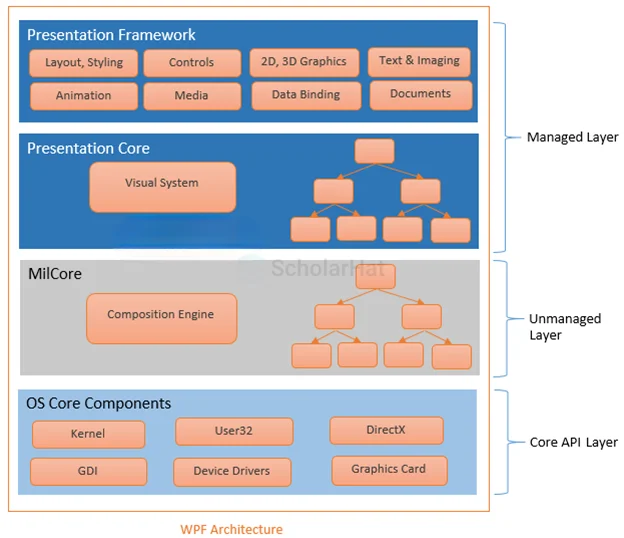06
DecUnderstanding WPF Architecture
Windows Presentation Framework is a next generation UI framework to create applications with a rich user experience. It is part of the .NET framework 3.0 and higher. WPF architecture is a layered architecture which have Managed, Unmanaged and Core API layers as shown in below fig.

Managed Layer
Managed layer has two main components – Presentation Framework and Presentation Core.
Presentation Framework provides the required functionalities that we need to build the WPF applications such as controls, data bindings, styling, shapes, media, documents, annotations, animation and more. PresentationFamework.dll is responsible for this purpose.
Presentation Core acts as a managed wrapper around MILCore and provides public interface for MIL. Presentation Core is the home for WPF Visual System and provides classes for creating application visual tree. The Visual System creates visual tree which contains applications Visual Elements and rendering instructions. PresentationCore.dll is responsible for this purpose.
Unmanaged Layer
This layer is also called milcore or Media Integration Library Core. MilCore is written in unmanaged code in order to enable tight integration with DirectX. DirectX engine is underlying technology used in WPF to display all graphics, allowing for efficient hardware and software rendering. MIL has Composition System that receives rendering instructions from Visual System and translates into data that can be understood by DirectX to render user interface.
Core API Layer
This layer has OS core components like Kernel, User32, GDI, Device Drivers, Graphic cards etc. These components are used by the application to access low level APIs. User32 manages memory and process separation.
What do you think?
I hope you will enjoy the tips while programming with WPF. I would like to have feedback from my blog readers. Your valuable feedback, question, or comments about this article are always welcome.







